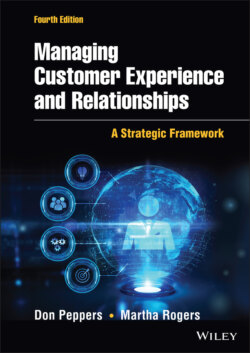Читать книгу Managing Customer Experience and Relationships - Don Peppers - Страница 42
PRODUCT COMPETENCE
ОглавлениеThe term “product competence” can be thought of in terms of both the product or service's reliability and its value. A product-competent enterprise is capable of rendering its products or services on schedule, seamlessly across multiple channels, at reasonable prices, and consistently through time in such a way that they don't need a lot of maintenance, repair, correction, or undue attention from a customer to meet the customer's need. Importantly, product competence is something every business must master just to have any reasonable chance for profit at all and it’s safe to say that by the end of the twentieth century nearly every business in the industrialized world had mastered the issue of basic product competence, for the simple reason that any company that remained product incompetent had either gone out of business already or been absorbed into a more competent firm.
A product or service can be considered reliable in the eyes of the customer if it directly and efficiently solves their problem (or does the job they're looking for) without introducing a host of other hassles, problems, or issues. It should perform as advertised, without failing or breaking down. And reliability is required not just of the physical product or service sold to a customer, but also with respect to all the different services that surround that product (e.g., invoicing and shipping, handling inquiries and requests, making repairs or service improvements, and protecting customers' data and privacy). The website should function smoothly and clearly, service should be performed on time, security flaws should be eliminated, and so forth. In addition, customers don't think in terms of departments or silos, so an enterprise that delivers its customer experience through the separate, uncoordinated activities of multiple operating entities or business units isn't likely to appear very reliable to the customer. Regardless of whatever internal elements are involved in running a business, a reliable customer experience can only be delivered by removing managers' internal focus and trying to repair the division between customer-facing and non-customer-facing groups and processes in order to deliver a single, unified experience to each customer. From billing and invoicing to technology implementations and employee training programs, all parts of an enterprise should be cognizant of their role in influencing the customer experience.
Product or service reliability is perhaps the easiest and most straightforward quality for an enterprise to monitor on a regular basis, but the enterprise has to be interested in monitoring it. As SVP of Customer Experience at Fidelity Investments, Parrish Arturi (currently Head of Digital Distribution at TIAA) focused his efforts on one small process improvement at a time to ratchet up the reliability of his company's customer experience. Importantly, he set up a customer experience improvement budget and allowed middle managers to tap it for small amounts of funds to fix these individual problems without having to do fully fleshed out proposals. The company set up a discussion board where employees could flag any problems or flaws in the company's services, and managers could then investigate the issue and follow up as needed. When one of Fidelity's frontline service reps noticed a surprising number of customers appeared to be having trouble simply logging into their accounts through the phone system, for instance, the rep started a thread on the discussion board, which called it to the attention of Arturi's team, who then worked with the phone system vendor to find the cause for the problem and identify a solution for it almost immediately.7 If Fidelity had not set up a specific employee channel (its discussion board) for raising these kinds of issues, the company might not have become aware of this problem for days, weeks, or even months, until some customer somewhere lodged a complaint.
A customer considers their experience to be valuable when the value-for-money ratio is appropriate. No one expects a Bergdorf experience when they go to Costco; no one drives a Lexus expecting it to feel like driving a Ford. But as Warren Buffett once said, “Price is what you pay. Value is what you get.” And this is an important point, because value can best be thought of as the total utility or usefulness delivered to a customer. It is an inherently subjective, squishy idea, while price is objective, exact, and easily quantified. On the one hand, price is something concrete that we can write down or divide into percentages. The value of a customer experience, on the other hand, like so much else, is completely in the eye of the beholder. Something has value for me if I say it does. In many situations, the value of the customer experience to a customer is closely related to its reliability. A more reliable customer experience will probably cost the enterprise less to maintain or manage, as well. At Fidelity, for instance, this is exactly what Arturi's team found. The cost of the customer experience team's fix for the phone system was a mere $20,000, but remedying the login problem for customers ended up saving Fidelity some $4 million annually in phone calls that no longer had to be handled by live representatives.8
Price is what you pay. Value is what you get.
—Warren Buffett
